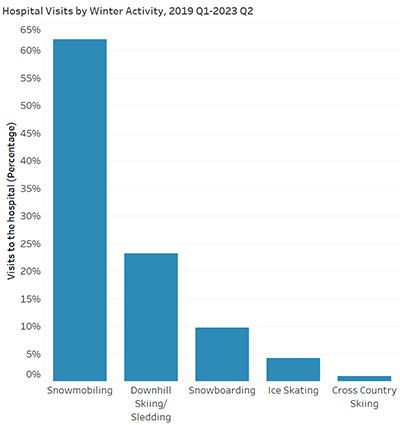Fast Facts from the WHA Information Center: Winter Sports Injuries
Winter in Wisconsin allows for many opportunities to get outdoors and enjoy the wonders that this time of year has to offer. Whether it is downhill skiing, sledding, or any other activity, there are potential dangers that come with winter activities. In 2018, the U.S. Consumer Product Safety Commission reported roughly 200,000 people treated at hospitals for winter sports injuries. The sport with the most injuries was downhill skiing, followed by snowboarding. Other common activities with a high number of injuries are snowmobiling, sledding and ice skating. The injuries commonly resulting from winter sport activities include sprains, dislocations and fractures.

The WHA Information Center analyzed claims from January 2019 through July 2023 to see how winter sport injuries are impacting Wisconsin hospitals and patients. Snowmobiling accidents had the highest number of visits to hospitals. The activity with the second most visits was downhill skiing, with snowboarding following closely behind. Males were seen more frequently and accounted for roughly 68% of all visits seen in a hospital related to a winter sport injury. The average age of a patient being seen at a hospital for a winter activity injury was 29 years of age. There is an increase in the number of visits from January-March when analyzing quarterly data. The ZIP code with the highest number of winter sports injury hospital visits is in Winnebago County, followed closely by a ZIP code located in Marathon County.

The following are some tips from the American Academy of Orthopedic Surgeons on how to prevent injuries from your favorite winter activities:
- Never participate alone in a winter sport.
- Keep in shape and condition muscles before participating in winter activities.
- Warm up thoroughly before playing or participating. Cold muscles, tendons and ligaments are vulnerable to injury.
- Wear appropriate protective gear, including goggles, helmets, gloves and padding.
- Check that equipment is working properly prior to use.
- Take a lesson (or several) from a qualified instructor, especially in sports like skiing and snowboarding. Learning how to fall correctly and safely can reduce the risk of injury.
- Pay attention to warnings about upcoming storms and severe drops in temperature.